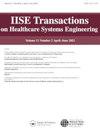资源有限的超人群传染病控制
IF 1.5
Q3 HEALTH CARE SCIENCES & SERVICES
IISE Transactions on Healthcare Systems Engineering
Pub Date : 2022-09-10
DOI:10.1080/24725579.2022.2115171
引用次数: 0
摘要
摘要受遏制2014年西非埃博拉疫情所面临的独特挑战的启发,我们制定了一个框架,将有限的资源动态分配给几个可能有关联的人群,在这些人群中,疾病传播是随机的。我们将这个问题表述为一个随机动态程序。然而,由于状态和操作空间随着问题的大小呈指数级增长,因此标准解决方案技术不适用。我们提出了两种解决方案方法以及几个基准策略。第一种方法考虑了一个动态的一步前瞻策略,该策略等效于一个非线性整数背包,它可以很好地随问题的大小而扩展。第二种方法是对文献中发现的近视发病率政策进行修改。除了在优化框架的模拟环境中测试所提出的政策外,我们还在一个案例研究中对2014年埃博拉疫情进行了大规模随机模拟。我们用塞拉利昂的真实世界数据校准并验证了随机模拟模型。我们的研究结果为在这种情况下有效的优先级排序和资源分配提供了见解。本文章由计算机程序翻译,如有差异,请以英文原文为准。
Infectious disease control in metapopulations with limited resources
Abstract Motivated by unique challenges faced in containing the 2014 Ebola outbreak in West Africa, we develop a framework to dynamically allocate limited resources to several possibly connected populations where the disease transmission is stochastic. We formulate this problem as a stochastic dynamic program. However, as the state and action spaces grow exponentially with the size of the problem, the standard solution techniques do not apply. We propose two solution methodologies along with several benchmark policies. The first approach considers a dynamic one-step look-ahead policy which is equivalent to a nonlinear integer knapsack that scales well with the problem size. The second approach is a modification of a myopic incidence policy found in the literature. In addition to testing the proposed policies in a simulation setting of the optimization framework, we develop a large-scale stochastic simulation for 2014 Ebola outbreak in a case study. We calibrate and validate the stochastic simulation model with real-world data from Sierra Leone. Our results provide insights on efficient prioritization and resource allocation in this setting.
求助全文
通过发布文献求助,成功后即可免费获取论文全文。
去求助
来源期刊

IISE Transactions on Healthcare Systems Engineering
Social Sciences-Safety Research
CiteScore
3.10
自引率
0.00%
发文量
19
期刊介绍:
IISE Transactions on Healthcare Systems Engineering aims to foster the healthcare systems community by publishing high quality papers that have a strong methodological focus and direct applicability to healthcare systems. Published quarterly, the journal supports research that explores: · Healthcare Operations Management · Medical Decision Making · Socio-Technical Systems Analysis related to healthcare · Quality Engineering · Healthcare Informatics · Healthcare Policy We are looking forward to accepting submissions that document the development and use of industrial and systems engineering tools and techniques including: · Healthcare operations research · Healthcare statistics · Healthcare information systems · Healthcare work measurement · Human factors/ergonomics applied to healthcare systems Research that explores the integration of these tools and techniques with those from other engineering and medical disciplines are also featured. We encourage the submission of clinical notes, or practice notes, to show the impact of contributions that will be published. We also encourage authors to collect an impact statement from their clinical partners to show the impact of research in the clinical practices.
 求助内容:
求助内容: 应助结果提醒方式:
应助结果提醒方式:


